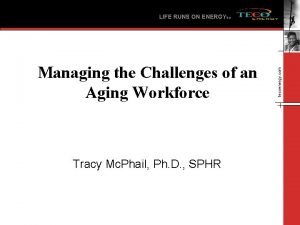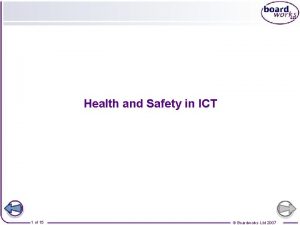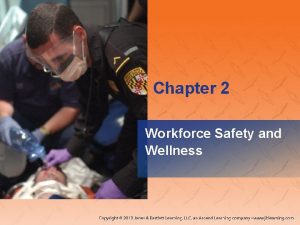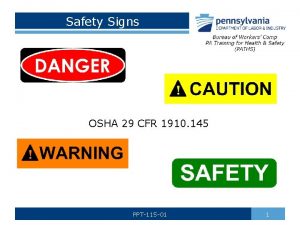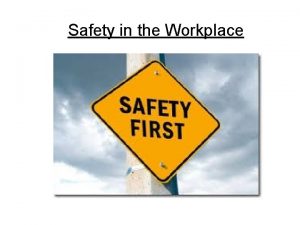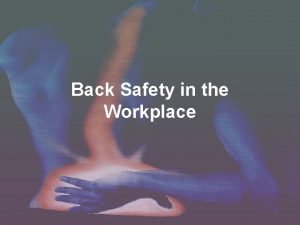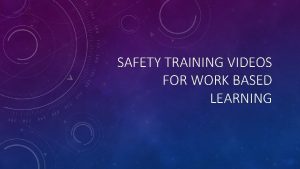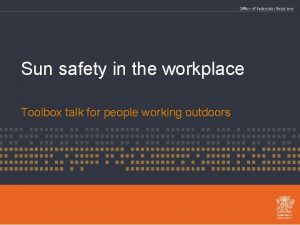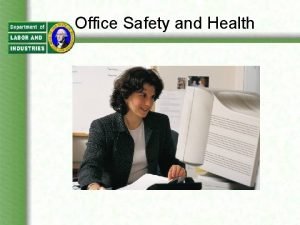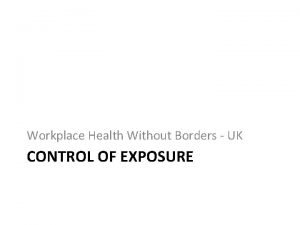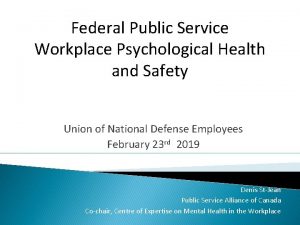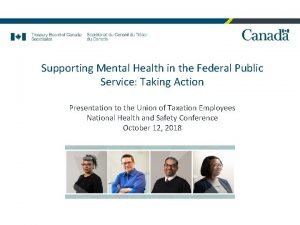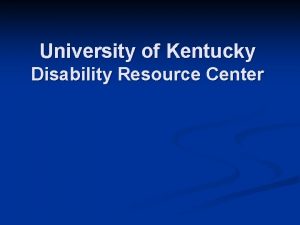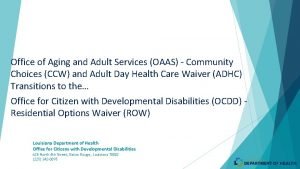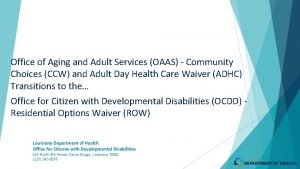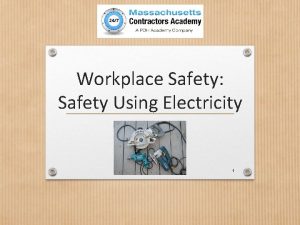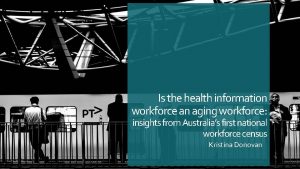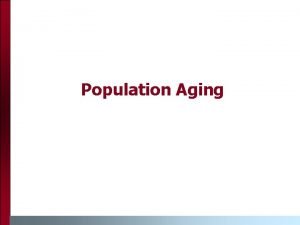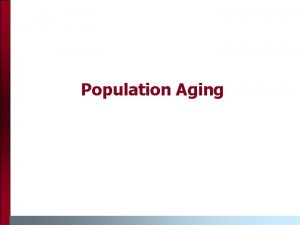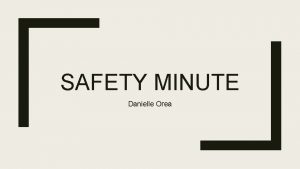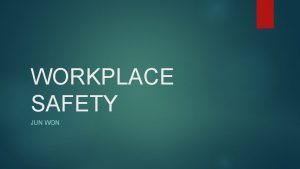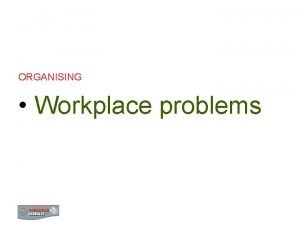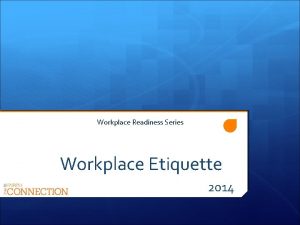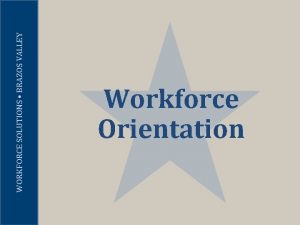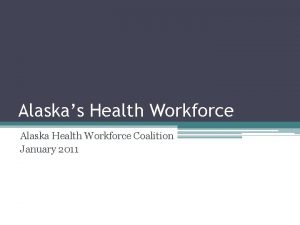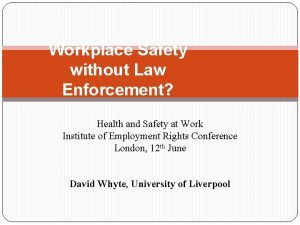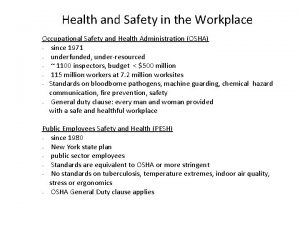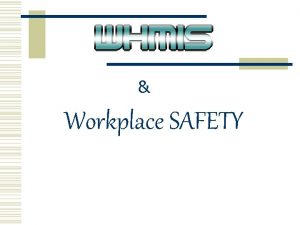Workplace Safety and Health for the Aging Workforce


















































- Slides: 50

Workplace Safety and Health for the Aging Workforce Work. Well Prevention & Care

Workplace Safety and Health for the Aging Workforce Presentation Overview • • • Workforce data Data on workplace injuries by age Employer benefits / concerns Understanding changes that occur with the aging process Workplace safety recommendation to prevent injuries

Workplace Safety and Health for the Aging Workforce Data The significance of the aging workforce

Workplace Safety and Health for the Aging Workforce Data on the Aging Workforce • 76 million babies born between 1946 – 1964 – Over next 2 decades an average of 10, 000 baby boomers per day will reach retirement age Bureau of Labor Statistics

Workplace Safety and Health for the Aging Workforce Age distribution 1990 blue (baby boomer 26 -44) 2000 red (age 36 -54 )

Workplace Safety and Health for the Aging Workforce United States AGE DISTRIBUTION Census. Scope

Workplace Safety and Health for the Aging Workforce Economic impact • • • In 2007, 5 people ages 20 -64 for every person 65 and older (5: 1) By 2030 (youngest of boomers turns 65) this number changes to less than 3: 1 IF baby boomers were to retire as was the trend in the 90’s, there would be a cascade of change • • Shortages in workforce labor Significant increase in Social Security benefits

Workplace Safety and Health for the Aging Workforce transition • • 50% of the workforce are baby boomers Baby bust occurred 1965 to mid 70’s A smaller “Echo boom” occurred in mid 70’s Consequences: – Current workforce is older – Smaller replacement pool to draw from

Workplace Safety and Health for the Aging Workforce Change in median age impact of the baby boom generation • • 1962 median age 40. 5 1978 median age 34. 8 2008 median age 40. 7 The New Workforce – Workforce will be transitioning from older more homogenous workforce to a younger diverse workforce. – Employers will need to take advantage of boomers working longer and transition leadership roles

Workplace Safety and Health for the Aging Workforce Workers 55 and older • Expected 7. 3 million workers age 55+ during 2006 -2016. • BLS spotlight on statistics 2008 -2018 – 50% of workforce are baby boomers – Projected increase in employment of 10. 1% – Most of increase will be due to job replacement rather than economic growth Bureau of Labor Statistics

Workplace Safety and Health for the Aging Workforce Postponed Retirement • Surveys – reasons for later retirements – – Stay active and engaged in professional field Increase in life expectancy Current financial concerns Decreasing retirement funds (401 K) • 21% of US workers are covered by a defined pension benefit – Need for healthcare coverage – Increase in age to qualify for Social Security Population Reference

Workplace Safety and Health for the Aging Workforce Employer Concerns and Workplace Injury Data

Workplace Safety and Health for the Aging Workforce Employer Concerns Impact on profitability due to: • Cost of health care • Worker compensation costs • Disability claims • Accommodation

Workplace Safety and Health for the Aging Workforce Healthcare and the older workers • Health care costs can be affected by age of companies workforce / use of services • Falls are more common in older workers – Twice as likely to sustain fractures than younger workers – Fatality from falls increases with age • Older workers generally require longer time for the healing process

Workplace Safety and Health for the Aging Workforce Older workers cost more ? FACTS: Work Comp experience 1998 -2002 • Younger workers experience more injuries (ages 25 -45) • Older workers experience injuries due to repetitions / age related – Rotator cuff sprains, Carpal tunnel syndrome

Workplace Safety and Health for the Aging Workforce US DOL 2004 Statistics Age 64 + = lowest number of injuries – Injuries tend to be related to repetitive use – Cost of injury tends to be higher » Wage difference is 1/3 rd of the difference » Duration to recover Ages 25 -44 = highest number of injuries – Number of injuries makes this group the most costly US Department of Labor

Workplace Safety and Health for the Aging Workforce Top 10 Injuries by medical costs The Journal of Workers Compensation - table from medical costs 1998 -2002 Costs in millions $ • Under age 40 – Lumbar disc displacement-$116 – Lumbar sprain -$98 – L-S sprain – $46 – Finger wound- $32 – Sprain shoulder - $24 – ACL sprain of knee – $22 – Sprain knee- $22 – Sprain neck- $22 – Rotator cuff sprain -$20 – Cervical disc displacement -$20 • Age 50 -70 – Rotator cuff sprain -$29 – Lumbar sprain- $24 – Lumbar disc displacement-$23 – L-S sprain-$12 – Tear medial meniscus- $11 – Carpal tunnel syndrome-$7 – Sprain knee -$7 – Sprain shoulder-$6 – Sprain neck - $6 – Cervical disc displacement-$5

Workplace Safety and Health for the Aging Workforce ADEA (1967) Age Discrimination in Employment Act • Current Employment Market in 2010 difficult for all ages. – ADEA - Protects individuals age 40 and older – Amended - OWBPA in 1990 • Older Workers Benefit Protection Act • Number of Age Discrimination receipts by EEOC is on the rise – 1997 15, 785 – 2003 19, 124 – 2008 24, 582 Equal Employment

Workplace Safety and Health for the Aging Workforce Employer Benefits of Retention • • Older employees hold key positions Have strong work ethic Reliable – less absenteeism Loyalty to the organization Less likely to change jobs Have gained people skills Enhanced judgment, decision making skills and general knowledge

Workplace Safety and Health for the Aging Workforce Retention of the older worker – Innovations will be driven by employers needs – Those that anticipate shortages will change: • Management practices • Work schedules • Benefit packages

Workplace Safety and Health for the Aging Workforce Employer Management Practices • Working with the older workforce requires – Clear communications – Clearly defined expectations • Training requirements – May require more time – Requires hearing / seeing / doing • Transition leadership roles • Incentives for recruitment in professional fields

Workplace Safety and Health for the Aging Workforce Work Schedules and Benefits • Scheduling – – – Flexibility Part-time Shared Weekender programs Work from home • Wellness Programs – Fitness – Stress reduction • Health care option – Pro-rated – Subsidized • Retirement benefits – Contributions to 401 K

Workplace Safety and Health for the Aging Workforce Specific Areas of Concern • BLS employment projections – 50% + of jobs in 2008 -2018 will be professional and related occupations • Employers with anticipated shortages – Healthcare, Technical, Engineering, Energy • One third of Physicians are now 55+ – American Nurses Association • Shortage to peak in 2020 with decrease of 20% from projected needs. • In 2004 average of nurse is 46. 8

Workplace Safety and Health for the Aging Workforce Examples Innovations by Employers in Healthcare • Ochsner Clinic Foundation in New Orleans – Work 4 hours/week to qualify for subsidized healthcare benefits • Scripps Health in San Diego, CA – 55+ with 20+ years at Scripps Health, receive full medical and prescription benefits if you work even a few hours. AARP on Health. Care

Workplace Safety and Health for the Aging Workforce Aging Process and Safety / Injury prevention • Understand the affects of aging. • Considerations for workplace safety for the older worker. – BONUS is this benefits all workers.

Workplace Safety and Health for the Aging Workforce Aging Process Varies from person to person Cannot generalize “Older worker” defined as age 40 and older

Workplace Safety and Health for the Aging Workforce Aging Process • Loss or decrease in – Range of Motion – Flexibility – Muscle mass – Bone Density – Balance – Cardiac output – Aerobic power – Joint changes (OA, DJD) • Changes in – Sleep regulation – Vision – Thermoregulation – Hearing – Short term memory – Energy / Activity level

Workplace Safety and Health for the Aging Workforce Additional Concerns • Medical history – Medications – Previous Injuries / Illness – Diabetes, Heart Attack, BP, etc. • Psycho-social history – Loss of spouse – Depression – Financial concerns

Workplace Safety and Health for the Aging Workforce Behavioral influences Diet Heart and blood vessel diseases increased in those who eat more meat and fat Increased incidence of diabetes when overweight Sun Exposure Increases risks of cataract formation and skin cancer Smoking Increase incidence of cancers Decreases lung function Exercise Weight bearing exercise and bone density Exercise to maintain muscle mass and improve balance Inactivity = loss of function, increase in weight Prevention behaviors Wearing hearing protection, sun screen, getting immunizations (flu) and medical check ups American Geriatric Society

Workplace Safety and Health for the Aging Workforce System Review and Safety Considerations

Workplace Safety and Health for the Aging Workforce Neuromuscular systems • Loss of 20% of muscle mass between ages of 20 to 60 – Decreased ability for heavy or sustained lifting • Loss of ROM & flexibility – Increase incidence of strains, arthritic change and/ or inflammatory process • Decrease balance – Increase incidence of falls • Decrease reaction time – Increase incidence of falls and slow reaction to danger

Workplace Safety and Health for the Aging Workforce Safety – changes in musculature • Provide mechanical devices for lifting and moving (carts, dolly, lifting devices) • Minimize lifting and reaching – Training in proper body mechanics, reduce loads, store heavy objects between mid-thigh and mid-chest height, use ladders • Provide adjustable seating & workstations – Reduces postural stresses / pressure points • Ergonomic tools – Larger Grips on tools, vibration dampening

Workplace Safety and Health for the Aging Workforce Safety – changes in bone density • Minimize slips/trips/falls – Reduce climbing and working at heights – Eliminate tripping hazards – Construct and mark floors, steps surfaces properly – Install fall protection barriers – Skid resistant floor surfaces – Proper maintenance – Eliminate obstructions and clutter in work areas – Use proper lighting and

Workplace Safety and Health for the Aging Workforce Falls Among Older Adults • 1 in 3 older adults fall each year. – Leading cause of injury deaths – Traumatic Brain Injury accounted for 46% of fatal falls in older adults (study in 2000) • Boston Globe (Dec. 10, 2006) – Those who die after suffering a hip fracture has increased from 24% in 1980 to 29% in 2006. • 19% in age group 65 -74 die within a year after a hip fracture and 36% in age group 85+ y. o. Center for Disease Control

Workplace Safety and Health for the Aging Workforce Safety – changes joints & tendons • Workstations (ergonomic analysis) – adjust height and distances to promote working in neutral positions & reduce contact stress • Reduce repetitions – Job rotations (between tasks or among workers) – Mechanize operations • Decrease vibration – Ergonomic tool selection with torque controls – Anti-vibration gloves

Workplace Safety and Health for the Aging Workforce Cardiovascular Changes with Age Cardiovascular disease process – Increase risk at age 45 for men, 55 for women – Increase incidences of hypertension, coronary artery disease, history of heart attack and stroke – Decreases energy / activity levels – Affects thermoregulatory system

Workplace Safety and Health for the Aging Workforce Respiratory Changes with Age • Respiratory system – – Aerobic power at 65 is 70% of what it was at age 25 Breathing capacity reduced by 40% between ages 30 and 65 Decreased lung elasticity Increased chest wall stiffness

Workplace Safety and Health for the Aging Workforce Safety - changes in cardiovascular & respiratory system • Activity – Energy level – Use mechanical devices for lifting and carrying – Job rotations alternating job tasks (heavy with light) • Thermoregulatory changes – Avoid working in extreme heat or cold – Stress importance of hydration – Provide environmental controls (AC) – Schedule work to avoid extremes (early morning)

Workplace Safety and Health for the Aging Workforce Other changes • Decreased short term memory – Affects how the older worker learns – Training methods • Hearing, seeing, doing and repetitions • Sleep regulation decreases – Causes increase recovery time when injured • Vision – Difficulty with focus and peripheral vision • Hearing – Loss of high level frequencies – Trouble discriminating in noisy environment

Workplace Safety and Health for the Aging Workforce Safety - for changes in hearing • Reduced ability to hear – Use of alarms, back up warning signals, etc. – Lower frequency sounds easier to hear – Speak clearly, confirm that information was heard correctly • Difficulty in noisy environment – Reduce exposure to noise – Shield or insulate noisy equipment – Provide hearing protection

Workplace Safety and Health for the Aging Workforce Safety - for changes in vision • • Improve work lighting Reduce glare by using several light sources Reduce sunlight glare with shades Add color contrasts (blue with yellow) Use font size 14 or greater Remove clutter from control panels Eye protection and encourage regular exams

Workplace Safety and Health for the Aging Workforce Safety – for changes in sensory / motor process • Changes in reaction times – – Control of pace related activities Transportation safety (55 Alive) Reduce potential for slips/trips/falls Use of high top boots on uneven surfaces • Decreased ability to multi-task – Reduce distractions

Workplace Safety and Health for the Aging Workforce Effective Training – – – Longer learning curve so spend time up front Communicate clearly Encourage participation Give opportunities to practice Use analogies or correlations they understand

Workplace Safety and Health for the Aging Workforce Worker Responsibilities • Healthy lifestyle – Exercise, diet, weight control, no smoking/substance abuse • Communicate needs – Essential in training and in day to day process • Follow safety procedures

Workplace Safety and Health for the Aging Workforce Benefits of Employer Health Promotions • • • Decrease health care costs Reduce Occupational Injury and Illness Improve employee performance Improve employee morale Increases ability to recruit and retain employees Positive response to needs of the workforce Healthy Workforce 2010.

Workplace Safety and Health for the Aging Workforce Wellness Programs • Increased health and wellness with – Fitness programs – Educational programs • Back care, body mechanics, cumulative trauma disorders – Stress reduction methods – Weight management – Smoking cessation classes

Workplace Safety and Health for the Aging Workforce Services for employers • • • Ergonomic analysis and recommendations Functional Job Analysis / Prework Screens On-site therapy services Health and wellness programs Employer training sessions Return to work programs for injured workers (work conditioning, FCE testing)

Workplace Safety and Health for the Aging Workforce Conclusion • Significant changes in the US workforce – In 2010 the beginning of the wave of older workers (baby boomers) reached age 64 • Increasing numbers staying in the workforce • Need for employer based programs and initiatives • Need for acclimating the workplace • Safety and wellness programs- opportunity for growth – Improve work safety for all – Retain older workers

Workplace Safety and Health for the Aging Workforce THANK YOU

Workplace Safety and Health for the Aging Workforce REFERENCES • • • AARP Public Policy Institute. Health and Safety issues in an aging workforce. Sara E. Rix, May 2001. IB Number 49. American Heart Organization. Cardiovascular disease statistics. www. americanheart. org Bureau of Labor and Statistics. www. bls. gov BLS Economic News Release, Employment Projections 2008 -2018. 12/9/09 BLS Spotlight on Statistics Worker Safety and Health www. bls. gov/spotlight Canada’s National Occupation Health and Safety Resource. www. ccohs. ca/oshanswers/psychosocial/aging_workers. html Equal Employment Opportunity Commission. www. eeoc. gov Healthy Workforce 2010. An essential health promotion sourcebook for employers large and small. http: //www. health. gov/healthypeople Human Resources and Employment, Government of Alberta. Safe and Health: A guide to managing an aging workforce. Monthly Labor Review. Trends in labor force participation in the United States. October 2006. Reuters. More Americans plan to delay retirement: survey. Oct. 22, 2009. The New Workforce: Age and Ethic Changes by Judi L. Mc. Clellan & Richard Holden (CA Employment Development Dept)
 Managing the aging workforce challenges and solutions
Managing the aging workforce challenges and solutions Ict workplace health and safety
Ict workplace health and safety Workforce safety and wellness chapter 2
Workforce safety and wellness chapter 2 29cfr1910 120
29cfr1910 120 Safety at work vocabulary
Safety at work vocabulary Chapter 10 workplace safety procedures
Chapter 10 workplace safety procedures Back safety in the workplace
Back safety in the workplace Osha training videos
Osha training videos Sun protection safety talk
Sun protection safety talk Office hazards
Office hazards Knife safety in the workplace
Knife safety in the workplace Workplace health without borders
Workplace health without borders Federal public service workplace mental health strategy
Federal public service workplace mental health strategy Federal public service workplace mental health strategy
Federal public service workplace mental health strategy Different market form of meat
Different market form of meat Jessie emily schofield poem analysis
Jessie emily schofield poem analysis Uky disability resource center
Uky disability resource center Dane county aging and disability resource center
Dane county aging and disability resource center Trends in cognitive sciences
Trends in cognitive sciences Office of aging and adults services
Office of aging and adults services Oaas as a service
Oaas as a service Iso 22301 utbildning
Iso 22301 utbildning Novell typiska drag
Novell typiska drag Nationell inriktning för artificiell intelligens
Nationell inriktning för artificiell intelligens Vad står k.r.å.k.a.n för
Vad står k.r.å.k.a.n för Varför kallas perioden 1918-1939 för mellankrigstiden?
Varför kallas perioden 1918-1939 för mellankrigstiden? En lathund för arbete med kontinuitetshantering
En lathund för arbete med kontinuitetshantering Underlag för särskild löneskatt på pensionskostnader
Underlag för särskild löneskatt på pensionskostnader Personlig tidbok
Personlig tidbok Sura för anatom
Sura för anatom Densitet vatten
Densitet vatten Datorkunskap för nybörjare
Datorkunskap för nybörjare Tack för att ni lyssnade bild
Tack för att ni lyssnade bild Debattinlägg mall
Debattinlägg mall För och nackdelar med firo
För och nackdelar med firo Nyckelkompetenser för livslångt lärande
Nyckelkompetenser för livslångt lärande Påbyggnader för flakfordon
Påbyggnader för flakfordon Formel för lufttryck
Formel för lufttryck Svenskt ramverk för digital samverkan
Svenskt ramverk för digital samverkan Lyckans minut erik lindorm analys
Lyckans minut erik lindorm analys Presentera för publik crossboss
Presentera för publik crossboss Teckenspråk minoritetsspråk argument
Teckenspråk minoritetsspråk argument Kanaans land
Kanaans land Klassificeringsstruktur för kommunala verksamheter
Klassificeringsstruktur för kommunala verksamheter Epiteltyper
Epiteltyper Bästa kameran för astrofoto
Bästa kameran för astrofoto Centrum för kunskap och säkerhet
Centrum för kunskap och säkerhet Verifikationsplan
Verifikationsplan Mat för unga idrottare
Mat för unga idrottare Verktyg för automatisering av utbetalningar
Verktyg för automatisering av utbetalningar Rutin för avvikelsehantering
Rutin för avvikelsehantering
